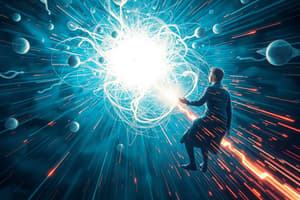Podcast
Questions and Answers
What is the unit of measurement for force, named after a famous scientist?
What is the unit of measurement for force, named after a famous scientist?
- Watt (W)
- Newton (N) (correct)
- Joule (J)
- Pascal (Pa)
Which of the following best describes the relationship between force and motion?
Which of the following best describes the relationship between force and motion?
- Force is necessary to maintain constant velocity.
- A force is anything that causes an object to accelerate. (correct)
- Force is the energy an object possesses due to its motion.
- An object requires a continuously applied force to keep moving.
An object has multiple forces acting upon it. How is the net force determined?
An object has multiple forces acting upon it. How is the net force determined?
- By considering only the largest force acting on the object.
- By multiplying all the forces together.
- By combining all forces, adding those in the same direction and subtracting those in opposite directions. (correct)
- By adding all the forces together regardless of direction.
What two components are required to fully describe a force?
What two components are required to fully describe a force?
A box is pushed to the right with a force of 20N and to the left with a force of 15N. What is the net force acting on the box?
A box is pushed to the right with a force of 20N and to the left with a force of 15N. What is the net force acting on the box?
Which of the following is NOT a possible effect of a force acting on an object?
Which of the following is NOT a possible effect of a force acting on an object?
A car is traveling at a constant speed. What can be said about the forces acting on the car?
A car is traveling at a constant speed. What can be said about the forces acting on the car?
Which of the following statements accurately describes the application of forces?
Which of the following statements accurately describes the application of forces?
Which of the following is the MOST accurate definition of friction?
Which of the following is the MOST accurate definition of friction?
In which scenario would minimizing friction be MOST advantageous?
In which scenario would minimizing friction be MOST advantageous?
What distinguishes static friction from sliding friction?
What distinguishes static friction from sliding friction?
Which type of friction is MOST relevant to a car's tires rolling on the road?
Which type of friction is MOST relevant to a car's tires rolling on the road?
Which of the following is an example of fluid friction?
Which of the following is an example of fluid friction?
What is the primary difference between contact and non-contact forces?
What is the primary difference between contact and non-contact forces?
Which of the following is an example of a contact force?
Which of the following is an example of a contact force?
What is the role of the normal force?
What is the role of the normal force?
Which of the fundamental forces is responsible for holding protons and neutrons together within the nucleus of an atom?
Which of the fundamental forces is responsible for holding protons and neutrons together within the nucleus of an atom?
What is the role of the weak nuclear force?
What is the role of the weak nuclear force?
Which of the fundamental forces is always attractive and acts between any two objects with mass?
Which of the fundamental forces is always attractive and acts between any two objects with mass?
Which force is responsible for the interactions between charged particles?
Which force is responsible for the interactions between charged particles?
Flashcards
What is a Force?
What is a Force?
A force is a push or a pull. It can cause an object to move, stop, or change direction.
What is Net Force?
What is Net Force?
The overall force acting on an object when all individual forces are combined.
Combining Forces
Combining Forces
Forces applied in the same direction are added together to calculate the net force.
Combining Opposite Forces
Combining Opposite Forces
Signup and view all the flashcards
What is Friction?
What is Friction?
Signup and view all the flashcards
How does Friction Occur?
How does Friction Occur?
Signup and view all the flashcards
Is Friction a Good Thing?
Is Friction a Good Thing?
Signup and view all the flashcards
What is Static Friction?
What is Static Friction?
Signup and view all the flashcards
What is Sliding Friction?
What is Sliding Friction?
Signup and view all the flashcards
What is Rolling Friction?
What is Rolling Friction?
Signup and view all the flashcards
What is Fluid Friction?
What is Fluid Friction?
Signup and view all the flashcards
What is Applied Force?
What is Applied Force?
Signup and view all the flashcards
What is Normal Force?
What is Normal Force?
Signup and view all the flashcards
What are Contact Forces?
What are Contact Forces?
Signup and view all the flashcards
What are Non-Contact Forces?
What are Non-Contact Forces?
Signup and view all the flashcards
What is Gravity?
What is Gravity?
Signup and view all the flashcards
What is Electromagnetic Force?
What is Electromagnetic Force?
Signup and view all the flashcards
Nuclear Force
Nuclear Force
Signup and view all the flashcards
Strong Nuclear Force
Strong Nuclear Force
Signup and view all the flashcards
Weak Nuclear Forces
Weak Nuclear Forces
Signup and view all the flashcards
Study Notes
-
A force is a push or pull that can cause an object to move, stop, or change direction.
-
In physics, a force accelerates objects.
-
A stationary object will not move without a force acting on it.
-
Forces can be applied in the same or opposite directions.
-
An object can have multiple forces applied to it simultaneously.
-
The net force is of interest, and it is the combination of all forces acting on an object.
-
The unit for measuring force is the Newton (N), named after Isaac Newton.
-
Forces come in pairs and have both magnitude and direction.
-
Force is a vector quantity.
-
Example: 5N, north (up) refers to a magnitude of 5N with an upward direction.
-
Effects of push and pull forces:
-
A force can make a stationary object move.
-
A force can stop a moving object.
-
A force can make an object move slower or faster.
-
A force can change the direction of a moving object.
-
Net Force
-
The overall force acting on an object after all forces are combined.
-
Forces in the same direction are added together.
-
Forces in opposite directions are subtracted.
-
Force should always include magnitude and direction.
-
To calculate net force, add forces in the same direction.
-
To calculate net force, subtract forces in opposite directions.
Types of Forces: Contact Forces
- Contact forces occur when interacting objects are physically touching each other.
- Friction force opposes the motion of objects that touch and move past each other.
- Normal force is a perpendicular force with which two objects push each other to prevent solid objects from passing through.
- Applied force occurs when a force is applied to something by a person or object.
Types of Forces: Non-Contact Forces
- Non-contact forces influence objects without physical contact.
- Types: Electromagnetic, gravity, and nuclear forces.
- Electromagnetic force combines magnetic fields and electrical interactions between charged particles.
- Gravity is a force that acts between any two masses.
- Nuclear force holds protons and neutrons within the nucleus.
- Weak nuclear force is responsible for radioactive decay, breaking down heavy atomic particles and releasing energy.
- Strong nuclear force acts only on hadrons (protons and neutrons inside the nucleus).
Friction
- Occurs when two surfaces slide or attempt to slide against each other.
- It slows down movement and acts in the opposite direction to the object's motion.
- Friction is a type of force that affects how things move.
- Friction is useful sometimes, such as preventing cars from skidding, keeping hands warm, and helping to grip objects.
- Less friction is desired when moving faster:
- Ice skaters use narrow blades to reduce friction.
- Olympic cyclists utilize narrow tires with few ridges to minimize friction and increase speed.
Types of Friction
- Static friction acts on objects that are not moving and opposes the applied force.
- Sliding friction opposes the motion of an object as it slides over a surface and occurs when objects rub or slide against each other.
- Rolling friction acts on rolling objects and occurs when a body rolls over another body's surface.
- Fluid friction opposes the motion of an object through a fluid and occurs between fluid layers moving relative to each other.
Applied and Normal forces
- Applied force
- A perpendicular force with which two objects push each other.
- The force that surfaces exert to prevent solid objects from passing through each other.
- Support force exerted on an object which is in contact with another.
- Normal force
- A perpendicular force with which two objects push each other.
- The force that surfaces exert to prevent solid objects from passing through each other.
- Support force exerted on an object which is in contact with another.
Four Fundamental Forces of Nature
- Strong force binds the nucleus.
- Electromagnetic force binds atoms.
- Weak force is involved in radioactive decay.
- Gravitational force binds the solar system.
Non-Contact Forces Explained
- Gravity
- Force between any two objects and is an attractive force due to their masses.
- Gravitational force is directly proportional to the product of the masses and inversely proportional to the square of the distance between them.
- Both gravity and air resistance affect the motion of a falling object.
- As objects fall, they accelerate.
- Gravity is always equal to the object's weight (W=mg), always attractive, and never repulsive.
- Electromagnetism
- Is more than a billion times stronger than gravity and combines magnetic and electrical fields between charged particles (positive and negative)/(protons and electrons).
- Unlike charges attract, and like charges repel each other.
- Works at an infinite range.
- Nuclear Force
- Prevents the mutual repulsion between positively charged protons.
- The strong force binds nuclear particles tightly; when lightweight elements fuse, it is called nuclear fusion releasing substantial energy.
- A tremendous amount of energy is released when heavy nuclei are broken apart, called nuclear fission.
- Weak nuclear forces are responsible for radioactive decay. This type helps generate sunlight and allows for medical diagnoses and treatment.
Strong Force
- Acts only on hadrons (protons and neutrons inside the nucleus).
- It is the strongest of all the basic forces of nature.
- Shortest range, of the order of 10^-15 m.
- Holds protons and neutrons together.
Weak Force
- Significant in nuclear processes, such as the beta-decay of certain nuclei.
Studying That Suits You
Use AI to generate personalized quizzes and flashcards to suit your learning preferences.




